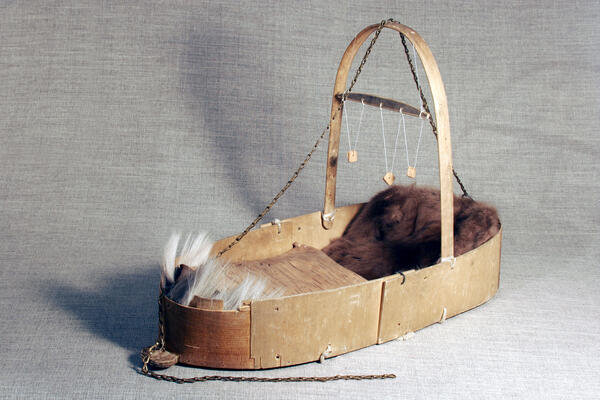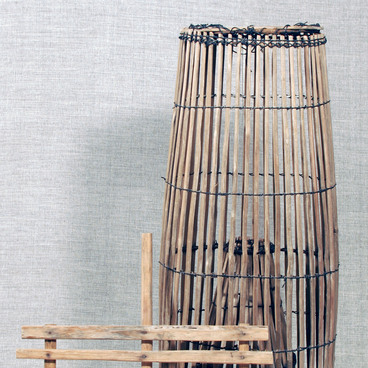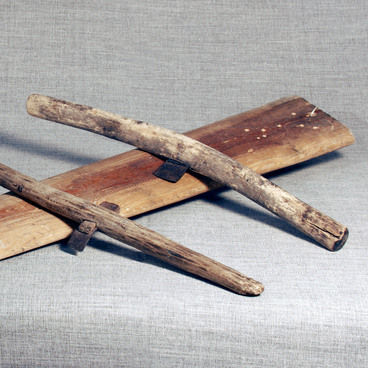A child’s birth is an important life event by the Forest NEnets, especially the first one’s. Partly, it is merely for practical reasons: if it’s a boy, he’ll become his father’s support and heir; if it’s a girl, she’ll become a helper to her mother and after she gets married, her bride-price will be the income to the family.
The head of the family makes a cradle for his firstborn, where the baby spends the first year of its life. It sleeps and stays awake in the cradle; it’s carried in sledges during migration in it. No matter how many children there are in the family, there’s only one cradle passed on to the youngers. It often becomes one of the most precious household items by the Forest Nenets.
In the recent past, a cradle was made of birch-bark, but as modern materials came into the NEnets lives, bark was replaced with plywood. Decoration of a cradle is a very important business traditionally done by women – a mother or elder sisters. They use beads, cloth, metal buttons and other items for this.
A cradle is oval with a flat bottom. From the inner side there are special belts attached to the bottom, that fasten a baby. Due to that, a mother can carry out household duties and breastfeed her baby at the same time without taking it out of the cradle. Before the modern hygiene items, young reindeer skin was put in the cradle, a birch tray in the shape of a shovel with saw- or hay-dust for absorption set slope over it. Over the sawdust there was fur taken from a reindeer beard.
The Forest NEnets cradle is well adapted for nomadic lifestyle. It is light and strong, it can easily be transported in a boat, tied up to a chum pole or simply a tree branch. For winter migration, there’s a special fur blanket made of reindeer fells or a quilt in a cradle. It covers the cradle completely leaving only a small hole for breathing, so a baby feels warm and comfy inside even in the frosty air.
The cradle displayed in the museum exposition was bought from the Forest Nenets Polina Turutina, a Tarko-Sale town resident.
The head of the family makes a cradle for his firstborn, where the baby spends the first year of its life. It sleeps and stays awake in the cradle; it’s carried in sledges during migration in it. No matter how many children there are in the family, there’s only one cradle passed on to the youngers. It often becomes one of the most precious household items by the Forest Nenets.
In the recent past, a cradle was made of birch-bark, but as modern materials came into the NEnets lives, bark was replaced with plywood. Decoration of a cradle is a very important business traditionally done by women – a mother or elder sisters. They use beads, cloth, metal buttons and other items for this.
A cradle is oval with a flat bottom. From the inner side there are special belts attached to the bottom, that fasten a baby. Due to that, a mother can carry out household duties and breastfeed her baby at the same time without taking it out of the cradle. Before the modern hygiene items, young reindeer skin was put in the cradle, a birch tray in the shape of a shovel with saw- or hay-dust for absorption set slope over it. Over the sawdust there was fur taken from a reindeer beard.
The Forest NEnets cradle is well adapted for nomadic lifestyle. It is light and strong, it can easily be transported in a boat, tied up to a chum pole or simply a tree branch. For winter migration, there’s a special fur blanket made of reindeer fells or a quilt in a cradle. It covers the cradle completely leaving only a small hole for breathing, so a baby feels warm and comfy inside even in the frosty air.
The cradle displayed in the museum exposition was bought from the Forest Nenets Polina Turutina, a Tarko-Sale town resident.



